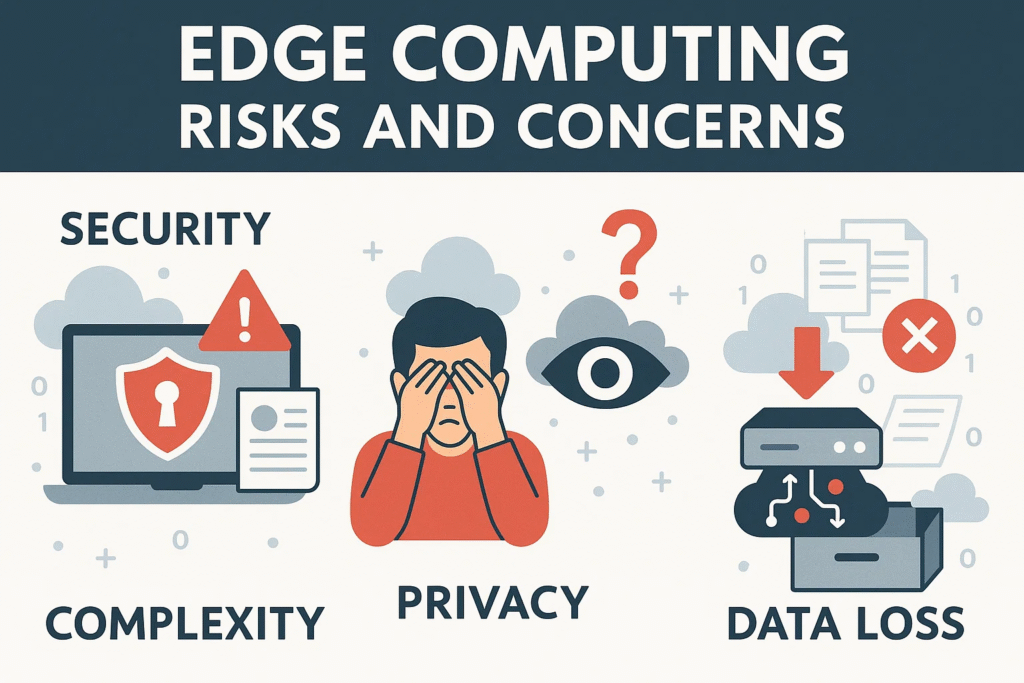Introduction
Edge computing has rapidly emerged as a game-changer for industries worldwide. By processing data closer to its source rather than relying solely on centralized cloud servers, edge computing enables faster response times, lower latency, and enhanced efficiency. However, like any technological advancement, it carries its own set of risks and concerns..
What is Edge Computing?
Edge computing refers to the practice of placing data processing nodes at or near the source of data generation—such as IoT devices, sensors, or local servers—instead of sending all data to a central data center or the cloud. This decentralized approach reduces the time it takes to transmit and process data.
Key benefits of edge computing include:
-
Reduced latency
-
Increased reliability
-
Lower bandwidth usage
-
Better support for real-time applications
-
Improved data privacy (when implemented correctly)
Yet, despite its advantages, edge computing is not without challenges.
Why Understanding Risks is Crucial
As organizations rush to adopt edge computing, understanding its risks becomes essential. Unlike traditional cloud systems, edge deployments involve a larger number of distributed nodes, devices, and endpoints—each of which introduces new vulnerabilities.
Failing to address these risks can lead to:
-
Data breaches
-
Operational downtime
-
Regulatory non-compliance
-
Financial losses
Key Risks and Concerns of Edge Computing
Below is a comprehensive table summarizing the primary risks and concerns of edge computing:
Table: Risks and Concerns of Edge Computing
| Risk/Concern | Description | Potential Impact | Mitigation Strategies |
|---|---|---|---|
| Data Security Breaches | Distributed edge devices create more entry points for cyberattacks. | Unauthorized access, data theft, or manipulation of sensitive data. | Use strong encryption, regular patching, and secure authentication mechanisms. |
| Physical Security | Edge devices may be installed in remote or unsecured locations. | Theft, tampering, or physical damage to devices. | Install tamper-proof hardware, surveillance, and access controls. |
| Network Vulnerabilities | Increased reliance on multiple networks for data transfer. | Network interception, DDoS attacks, or packet sniffing. | Employ firewalls, VPNs, intrusion detection systems, and segmented networks. |
| Regulatory Compliance | Data processed locally may cross regulatory boundaries. | Legal issues, fines, and reputation damage. | Understand jurisdictional laws, implement compliance frameworks like GDPR. |
| Data Integrity Issues | Inconsistent updates or corrupted edge nodes. | Data loss, errors in analytics, or poor decision-making. | Regular integrity checks, data replication, and centralized monitoring. |
| Device Management Complexity | Managing thousands of edge devices can be difficult. | Increased maintenance costs and operational inefficiency. | Centralized device management platforms, automated updates, and predictive maintenance. |
| Latency in Synchronization | Delays between edge nodes and the cloud can create inconsistencies. | Outdated or conflicting information across systems. | Adopt real-time synchronization protocols and caching strategies. |
| Insider Threats | Local operators or third-party technicians may mishandle data. | Data leaks or intentional sabotage. | Strict access controls, auditing, and role-based permissions. |
| Energy and Cost Overheads | Maintaining edge infrastructure requires power and operational costs. | Higher TCO (Total Cost of Ownership). | Energy-efficient hardware, capacity planning, and cost optimization tools. |
| Scalability Concerns | Scaling up edge nodes introduces new complexities. | Slower deployment, increased risk of vulnerabilities. | Plan architecture for scalability, modular deployments. |
Deep Dive into the Risks
1. Data Security Breaches
One of the biggest risks in edge computing is cybersecurity. Unlike centralized systems, edge devices spread across many locations increase the attack surface exponentially. If attackers compromise a single node, they can gain access to sensitive data or disrupt operations.
Solution:
-
Implement end-to-end encryption.
-
Use zero-trust architecture.
-
Conduct regular penetration testing.
2. Physical Security Challenges
Edge devices are often deployed in remote or semi-public areas. This makes them vulnerable to theft, vandalism, or tampering.
Solution:
-
Harden devices physically with tamper detection.
-
Employ security cameras and sensors.
-
Limit physical access to authorized personnel.
3. Network Vulnerabilities
Since edge computing relies on various network connections—wired, wireless, or cellular—it creates multiple attack vectors. Poorly configured networks can lead to data interception or denial-of-service attacks.
Solution:
-
Encrypt network traffic using VPNs or TLS.
-
Segment networks to isolate critical devices.
-
Use intrusion prevention systems.
4. Regulatory and Compliance Risks
Data sovereignty and privacy laws, like GDPR in Europe, require strict control over where and how data is processed. Edge computing, by design, may process data locally, making compliance more complex.
Solution:
-
Implement data localization policies.
-
Maintain detailed audit logs.
-
Work with legal teams to ensure adherence to laws.
5. Data Integrity and Quality Issues
Edge nodes may process and store data inconsistently. Without proper synchronization, businesses risk inaccurate analytics or decisions based on outdated information.
Solution:
-
Use real-time data replication to central servers.
-
Regularly audit data for anomalies.
-
Build redundancy into critical systems.
6. Device Management Complexity
Managing thousands of edge nodes—each with its own software, firmware, and security patches—can overwhelm IT teams.
Solution:
-
Deploy centralized management tools.
-
Automate software updates.
-
Use predictive analytics for maintenance planning.
7. Latency and Synchronization Issues
If edge nodes and cloud servers fall out of sync, it can cause inconsistent datasets, delays in decision-making, or system errors.
Solution:
-
Implement robust caching strategies.
-
Use synchronization protocols optimized for low latency.
8. Insider Threats
Local operators or third-party technicians may intentionally or unintentionally compromise systems.
Solution:
-
Enforce least-privilege access.
-
Conduct background checks.
-
Maintain audit trails of all actions.
9. Energy and Cost Overheads
Edge computing often requires additional infrastructure—servers, sensors, and communication systems—which increases operational costs.
Solution:
-
Deploy energy-efficient devices.
-
Conduct ROI analysis before expansion.
-
Optimize workload placement.
10. Scalability Concerns
Scaling up edge operations isn’t just a technical issue; it also involves logistical, financial, and security complexities.
Solution:
-
Plan modular architecture.
-
Use containerization for easy deployment.
-
Design security and compliance frameworks from the start.
Best Practices to Mitigate Edge Computing Risks
-
Zero-Trust Security Model
Never trust by default. Authenticate and authorize every device, user, and application. -
Regular Security Updates and Patching
Ensure all edge devices receive timely updates. Outdated software is one of the most common vulnerabilities. -
Centralized Monitoring and Analytics
Use dashboards to track the health, performance, and security of all edge devices in real time. -
Data Encryption and Tokenization
Protect data at rest and in transit to reduce exposure even if systems are compromised. -
Incident Response Planning
Prepare for breaches with clear escalation protocols, backup systems, and disaster recovery plans. -
Vendor and Supply Chain Risk Management
Scrutinize vendors to ensure they follow security best practices.
Future Outlook: Balancing Innovation and Security
Edge computing is not slowing down. According to market forecasts, billions of IoT and smart devices will be connected to edge networks within the next few years. This growth makes it vital for businesses to invest in security, compliance, and scalable management practices.
Companies that strike the right balance between innovation and risk management will gain a significant competitive edge.
Conclusion
Edge computing is a revolutionary technology poised to transform industries, but it also introduces significant risks. Organizations must plan proactively to secure their infrastructure, protect data, and comply with regulations. By understanding and mitigating these risks early, businesses can unlock the full potential of edge computing without compromising security or reliability.

